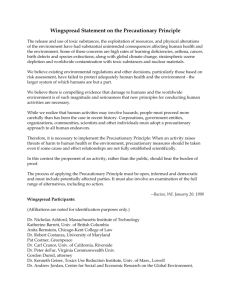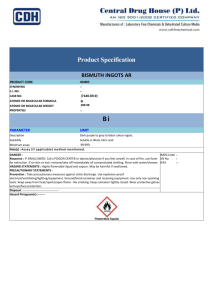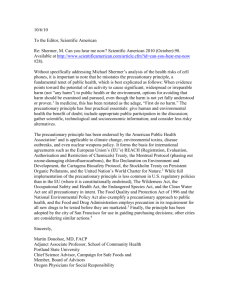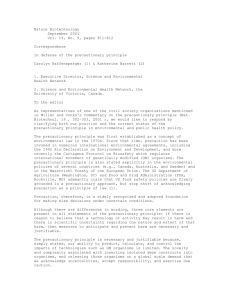United Nations
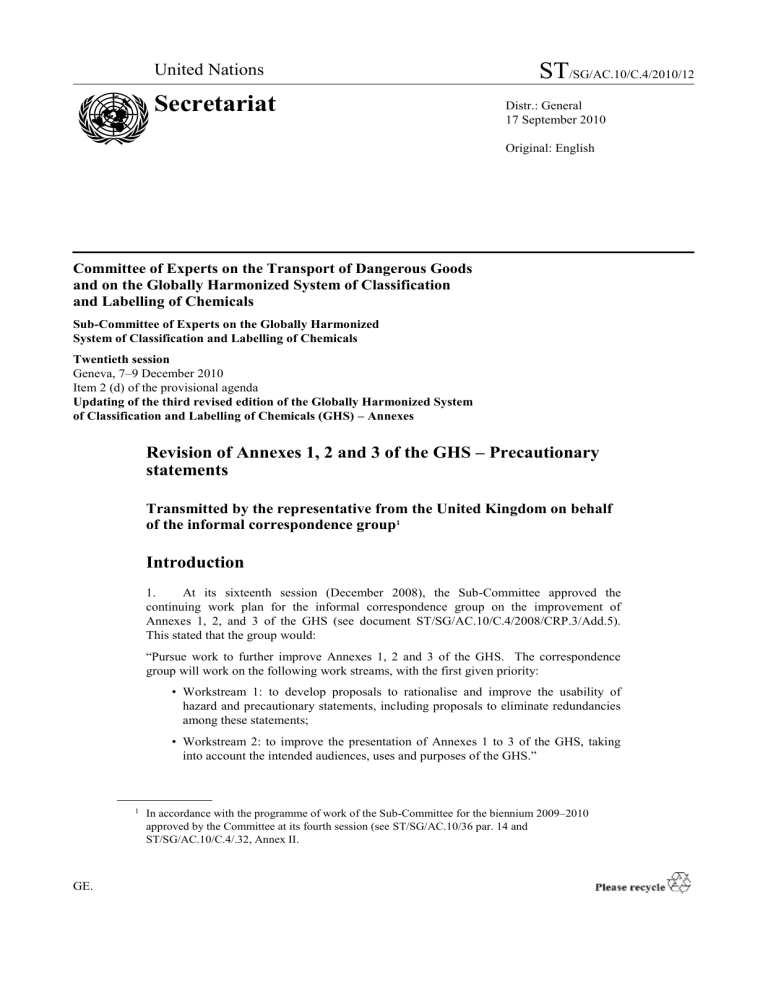
United Nations
Secretariat
ST
/SG/AC.10/C.4/2010/12
Distr.: General
17 September 2010
Original: English
Committee of Experts on the Transport of Dangerous Goods and on the Globally Harmonized System of Classification and Labelling of Chemicals
Sub-Committee of Experts on the Globally Harmonized
System of Classification and Labelling of Chemicals
Twentieth session
Geneva, 7–9 December 2010
Item 2 (d) of the provisional agenda
Updating of the third revised edition of the Globally Harmonized System of Classification and Labelling of Chemicals (GHS) – Annexes
Revision of Annexes 1, 2 and 3 of the GHS – Precautionary statements
Transmitted by the representative from the United Kingdom on behalf of the informal correspondence group
1
Introduction
1. At its sixteenth session (December 2008), the Sub-Committee approved the continuing work plan for the informal correspondence group on the improvement of
Annexes 1, 2, and 3 of the GHS (see document ST/SG/AC.10/C.4/2008/CRP.3/Add.5).
This stated that the group would:
“Pursue work to further improve Annexes 1, 2 and 3 of the GHS. The correspondence group will work on the following work streams, with the first given priority:
• Workstream 1: to develop proposals to rationalise and improve the usability of hazard and precautionary statements, including proposals to eliminate redundancies among these statements;
• Workstream 2: to improve the presentation of Annexes 1 to 3 of the GHS, taking into account the intended audiences, uses and purposes of the GHS.”
1 In accordance with the programme of work of the Sub-Committee for the biennium 2009–2010 approved by the Committee at its fourth session (see ST/SG/AC.10/36 par. 14 and
ST/SG/AC.10/C.4/.32, Annex II.
GE.
ST/SG/AC.10/C.4/2010/12
2. In accordance with workstream 1 of this work programme, this document presents a set of proposals to rationalise the precautionary statements in Annex 3 of the GHS.
Background
GHS precautionary statements
3. Presently there are a number of factors limiting the usability of the GHS precautionary statements:
(a) A high number of precautionary statements may be triggered for a substance or mixture, even with a relatively simple classification. Including all the statements triggered for a given chemical would arguably confuse the user and reduce the effectiveness of hazard and safety communication.
(b) Selection of appropriate precautionary statements by manufacturers and suppliers can be difficult when a large number are triggered.
(c) Different hazard classifications trigger similar but different precautionary statements, leading to arguably unnecessary small differences between precautionary measures recommended in different circumstances.
4. To illustrate these problems, three examples of substances are given in
UN/SCEGHS/20/INF.3, together with the list of precautionary statements that are triggered.
(The classifications are based on those given in the European Union harmonised classification list given in Part 3.1 of Annex VI of EC Regulation 1272/2008 2 ). It can be seen that a large number of precautionary statements are triggered in each case, to the extent that hazard communication is likely to be obscured if all are included on a chemical label.
5. For these reasons, the informal correspondence group has been considering a number of approaches to rationalising and improving the usability of the GHS precautionary statements. These approaches have been outlined in more detail in previous informal documents (UN/SCEGHS/15/INF.26, UN/SCEGHS/16/INF.24,
UN/SCEGHS/18/INF.18). However, they include:
(a) Editorial amendments to rationalise/reduce/shorten the existing precautionary statements
(b) Development of new combinations of precautionary statements
(c) Re-grouping of precautionary statements
(d) Provision of further guidance for selection of precautionary statements, in particular using the “conditions for use” column in the tables in Annex 3, section 3, of the GHS
(e) Forming an “order of preference” for precautionary statements, allowing some to be prioritised over others;
2 Regulation (EC) No 1272/2008 of the European Parliament and of the Council of 16 December 2008, on classification, labelling and packaging of substances and mixtures, amending and repealing
Directives 67/548/EEC and 1999/45/EC, and amending Regulation (EC) No 1907/2006.
2
ST/SG/AC.10/C.4/2010/12
(f) Use of “signpost statements” which direct the user of a chemical to alternative places where safety information can be given, such as a safety data sheet or instructions for use.
6. This document presents a set of amendments to help rationalise and in some cases clarify the existing precautionary statements. The proposed amendments mostly fall within approach (a) above (editorial amendments/rationalisations), though in some cases they also draw on the other approaches.
7. The full proposal is given in Annex 1 to this document. By way of supporting information, UN/SCEGHS/20/INF.3 contains:
(a) an explanation of each proposed change;
(b) examples of the precautionary statements triggered by three example substances which trigger a relatively large number of precautionary statements;
(c) a full version of the precautionary statement table in part 3 of Annex 3 of the
GHS with the proposed changes marked.
8. While the informal correspondence group on Annexes 1-3 hopes that these proposals make valuable progress towards rationalising and improving the GHS precautionary statements, it can be seen that the effect of these changes remains relatively small. The informal group therefore proposes to continue its work on improving the usability of precautionary statements during the next biennium, in particular to further explore the scope for using approaches (b) – (f) to assist in rationalising the precautionary information required on labels. Terms of reference for this continuing work will be proposed separately at the twentieth session.
3
ST/SG/AC.10/C.4/2010/12
Annex 1
Proposal
Annex 3, section 2
A3.2.3.7 Amend the first sentence to read:
“To facilitate translation into the languages of users, precautionary statements have been broken down into individual sentences or parts of sentences in the tables in this section.”
Add a new paragraph to read:
“Where square brackets [...] appear around some text in a precautionary statement, this indicates that the text in square brackets is not appropriate in every case and should be used only in certain circumstances. In these cases, conditions for use explaining when the text should be used are given in column (5). For example, P284 states, " [In case of inadequate ventilation] wear respiratory protection .
" This statement is given with the condition for use – text in square brackets may be used if additional information is provided with the chemical at the point of use that explains what type of ventilation would be adequate for safe use . The application of the condition for use should be interpreted as follows. If additional information is provided with the chemical explaining what type of ventilation would be adequate for safe use, the text in square brackets may be used. In this case, the statement would read , "In case of inadequate ventilation wear respiratory protection .
" However, if the chemical is supplied without such information, the text in square brackets should not be used, and the precautionary statement should read , "Wear respiratory protection
.”
Replace paragraph reference “A3.2.3.7” with “A3.2.3.8”
Annex 3, section 3
Amend the precautionary statements in the tables A3.2.2, A3.2.3, A3.2.4, A3.2.5 and the table in A3.3.5.1 as follows:
P223
Amend to read “Do not allow contact with water.”
P244
Amend to read “Keep values and fittings free from oil and grease.”
P261
In table A3.2.2 add the condition for use “ - may be omitted if P260 is given on the label ” to column 5.
In the table in A3.3.5.1 add “ - may be omitted if P260 is given on the label ” after
“Manufacturer/supplier or the competent authority to specify applicable conditions” for all entries of P261.
4
ST/SG/AC.10/C.4/2010/12
P280
Extend to cover Explosives (chapter 2.1), unstable explosive; Germ cell mutagenicity
(chapter 3.5) categories 1A, 1B, 2; Carcinogenicity (chapter 3.6) categories 1A, 1B, 2; and
Reproductive toxicity, categories 1A, 1B, 2.
Add the condition for use “Manufacturer/supplier or the competent authority to specify type of equipment” to column 5 of Table A3.2.2 for each new hazard class covered, and under each new entry of P280 in the tables in A3.3.5.1.
P281
Delete throughout.
P284
Amend throughout to read: “[In case of inadequate ventilation] wear respiratory protection” and extend to cover respiratory sensitization (chapter 3.4).
Add the condition for use “ - text in square brackets may be used if additional information is provided with the chemical at the point of use that explains what type of ventilation would be adequate for safe use .” to column 5 of Table A3.2.2 and after each entry of P284 in the tables in A3.3.5.1.
P285
Delete throughout.
P307
Delete individual entry in Table A3.2.3.
Replace all occurrences of P307 in combined statements with P308 “IF exposed or concerned.”
P308
Extend individual entry in Table A3.2.3 to cover Specific target organ toxicity, single exposure (chapter 3.8), categories 1, 2.
P309
Delete individual entry in Table A3.2.3.
Replace all occurrences of P309 in combined statements with P308 “IF exposed or concerned.”
P310
Amend individual entry in Table A3.2.3 and all occurrences in combined precautionary statements to read “Immediately call a POISON CENTER/doctor/…”.
Add the condition for use “Manufacturer/supplier or the competent authority to specify the appropriate source of emergency medical advice.” to column 5 of Table A3.2.3 for the individual entry and for each combined precautionary statement containing P310, and after each precautionary statement containing P310 in the tables in A3.3.5.1.
P311
Amend individual entry in Table A3.2.3 and all occurrences in combined precautionary statements to read “Call a POISON CENTER/doctor/…”.
Add the condition for use “Manufacturer/supplier or the competent authority to specify the appropriate source of emergency medical advice.” to column 5 of Table 3.2.3 for the individual entry and for each combined precautionary statement containing P311, and after each precautionary statement containing P311 in the tables in A3.3.5.1.
5
ST/SG/AC.10/C.4/2010/12
P312
Amend individual entry in Table A3.2.3 and all occurrences in combined precautionary statements to read “Call a POISON CENTER/doctor/… if you feel unwell”.
Add the condition for use “Manufacturer/supplier or the competent authority to specify the appropriate source of emergency medical advice.” to column 5 of Table 3.2.3 for the individual entry and for each combined precautionary statement containing P312, and after each precautionary statement containing P312 in the tables in A3.3.5.1.
P321
Extend to cover Acute toxicity, dermal (chapter 3.1), categories 1, 2 and Acute toxicity, dermal (chapter 3.1), categories 3, 4.
Add the condition for use “… Reference to supplemental first aid instruction. – if immediate measures such as specific cleansing agent is advised ” to column 5 of Table 3.2.3 for these hazard categories, and after each entry for P321 in the tables in A.3.3.5.1 covering these hazard categories.
P322
Delete throughout.
P340
Amend individual entry in Table A3.2.3 and all occurrences in combined precautionary statements to read “Remove person to fresh air and ensure comfortable breathing.”
Extend individual entry in Table A3.2.3 to cover Respiratory sensitization (chapter 3.4), categories 1, 1A, 1B.
P341
Delete individual entry in Table A3.2.3.
P350
Delete individual entry in Table A3.2.3.
P352
Amend individual entry in Table A3.2.3 and all occurrences in combined precautionary statements to read, “Wash with plenty of water/….”
Extend individual entry in Table A3.2.3 to cover Acute toxicity, dermal (chapter 3.1), categories 1 and 2.
Add the condition for use “Manufacturer/supplier or the competent authority may specify a cleansing agent if appropriate, or may recommend an alternative agent in exceptional cases if water is clearly inappropriate” to column 5 of Table A3.2.3 (for both individual and combined entries) and after each entry for P352 as part of a combined precautionary statement in the tables in A3.3.5.1.
P361
Amend individual entry in Table A3.2.3 and all occurrences in combined precautionary statements to read “Take off immediately all contaminated clothing.”
P362
Amend individual entry in Table A3.2.3 and all occurrences in combined precautionary statements to read “Take off contaminated clothing.”
Extend individual entry in Table A3.2.3 to cover Acute toxicity, dermal (chapter 3.1), category 4 and Skin sensitization (chapter 3.4), categories 1, 1A, 1B.
6
ST/SG/AC.10/C.4/2010/12
P363
Under columns 3 and 4, delete rows for Acute toxicity, Dermal, categories 1, 2, 3, 4 and
Skin sensitisation 1, 1A, 1B.
After P363, add a new row containing the precautionary statement P364, to read “and wash it before reuse.”. Under columns 3 and 4 apply this to hazard classes Acute toxicity, dermal
(chapter 3.1) categories 1, 2, 3, 4, and Skin irritation (chapter 3.2), category 2.
P378
Amend individual entry in Table A3.2.3 and all occurrences in combined precautionary statements to read, “Use … to extinguish.”
P302 + P350
Delete throughout.
P304 + P340
Extend to cover Respiratory sensitization (chapter 3.4), categories 1, 1A, 1B.
P304 + P341
Delete throughout.
P308 + P313
Extend to cover Specific target organ toxicity, single exposure (chapter 3.8), categories 1, 2.
P332 + P313
Add condition for use “ - may be omitted when P333 + P313 appears on the label ” to column 5 of Table 3.2.3 and after each entry for P332 + P313 in the tables in A3.3.5.1.
New combined precautionary statements
P361 + P364
Add a row under P342 + P311, containing the new combined precautionary statement,
P361 + P364, “Take off immediately all contaminated clothing.”.
Under columns 3 and 4 apply this to Acute toxicity, dermal (chapter 3.1), categories 1, 2, 3.
Add this combined statement to the column, “Response” in the table for each of these hazard classes under A3.3.5.1.
P362 + P364
Under P361 + P364 add a row containing the new combined precautionary statement, P362
+ P364, “Take off contaminated clothing and wash it before reuse.”
Under columns 3 and 4 apply this to Acute toxicity, dermal (chapter 3.1), category 4, Skin irritation (chapter 3.2), category 2, and Skin sensitization (chapter 3.4), categories 1, 1A,
1B.
Add this combined statement to the column, “Response” in the table for each of these hazard classes under A3.3.5.1.
7

